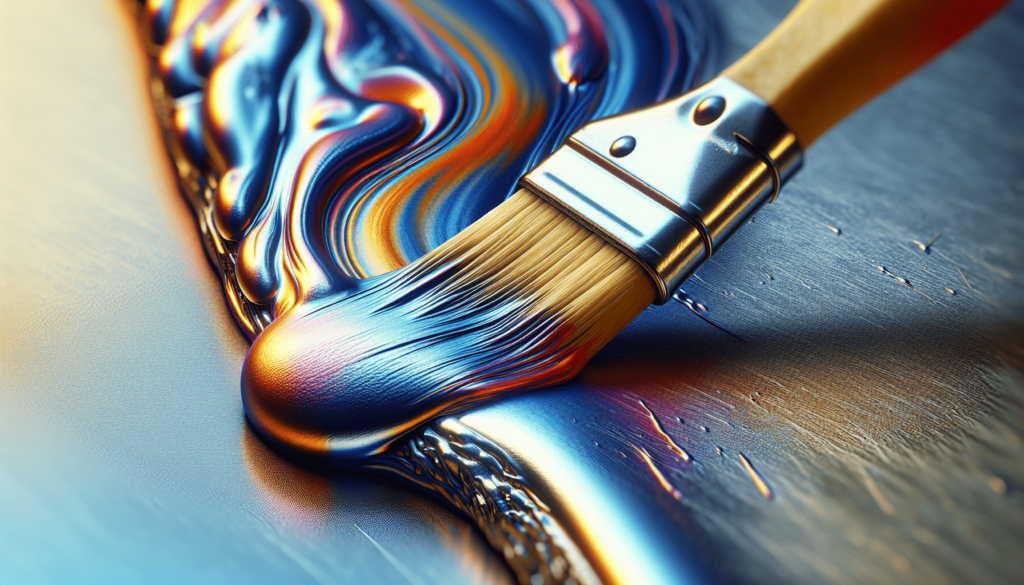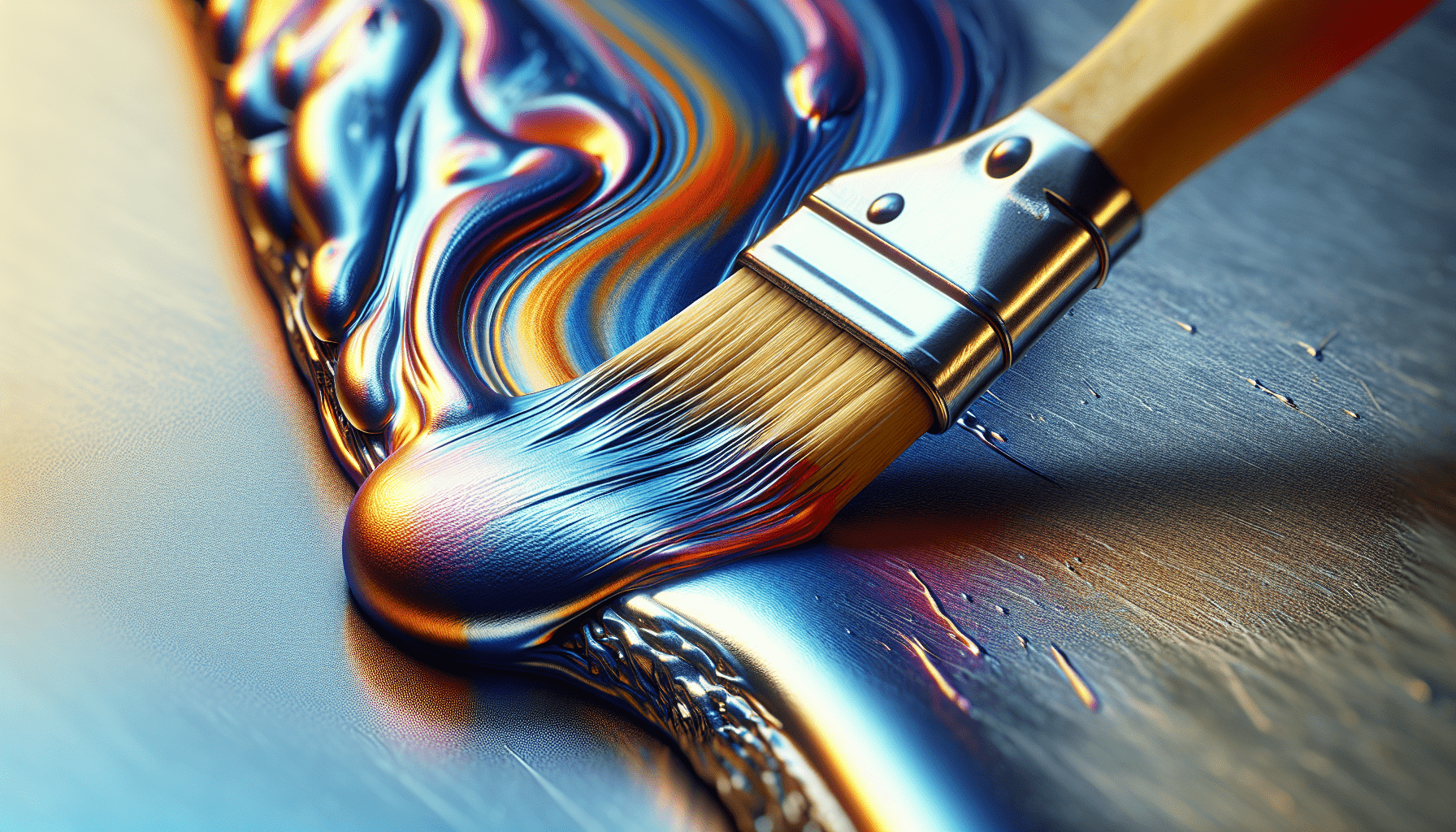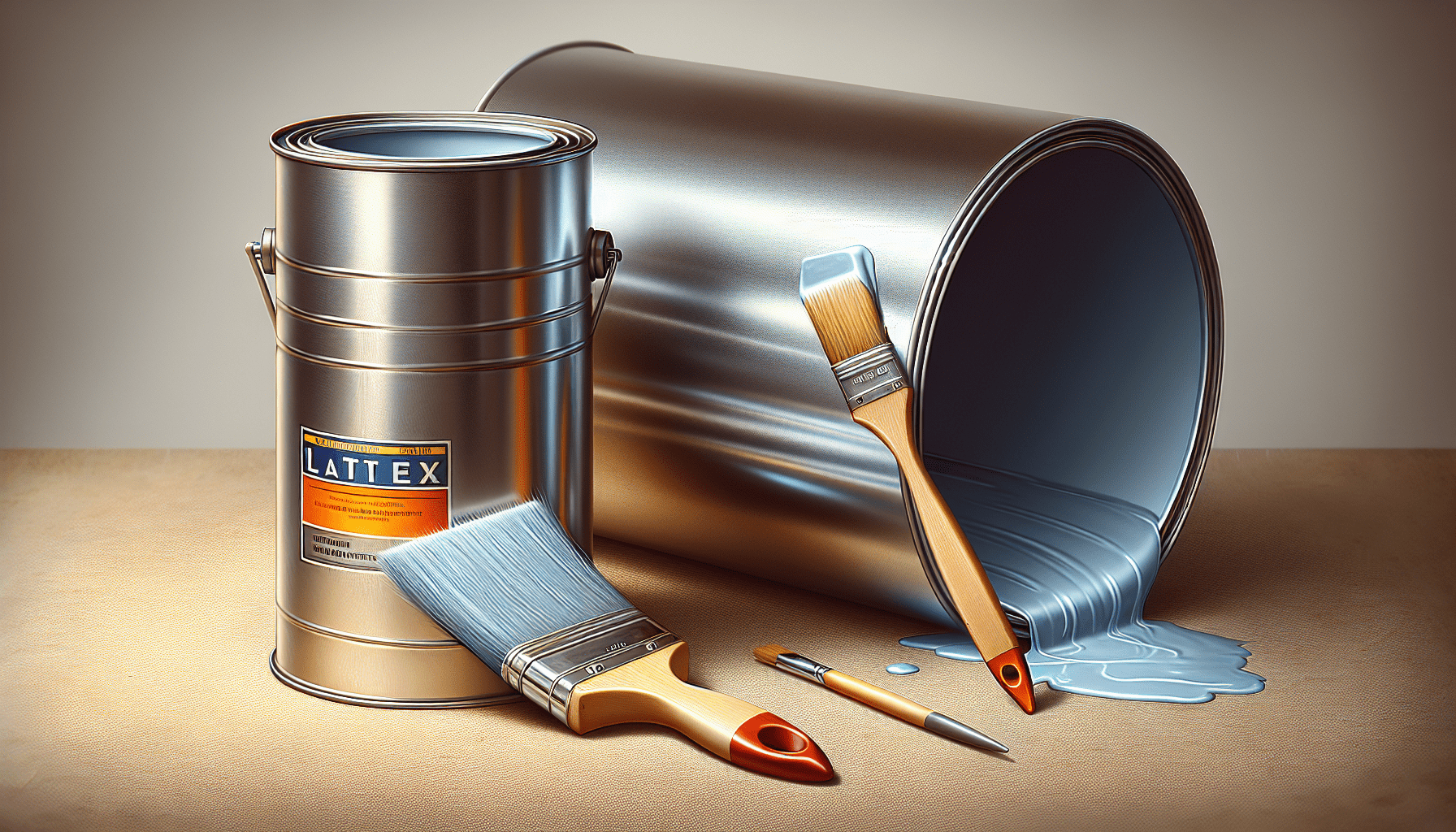Latex paint is a popular choice for many home improvement projects due to its easy application and durability. However, when it comes to painting metal surfaces, there is a common question that arises: will latex paint stick to metal? In this article, we will explore the compatibility of latex paint with metal surfaces, discussing the factors that may affect the adhesion and providing useful tips to ensure a successful outcome. Whether you are planning to paint a metal door, furniture, or any other metal object, understanding the interaction between latex paint and metal is crucial for achieving a long-lasting and professional finish.

Understanding Latex Paint
Definition of latex paint
Latex paint, also known as acrylic paint, is a water-based paint that is commonly used for interior and exterior applications. It is made up of binder particles that are suspended in water. These particles are composed of synthetic polymers such as acrylic, vinyl, or a combination of both. Latex paint is known for its ease of use, its fast drying time, and its ability to produce a durable and long-lasting finish.
Composition of latex paint
Latex paint consists of various components that work together to provide its unique properties. The primary ingredients of latex paint include binders, pigments, solvents, and additives. Binders are responsible for binding the pigments and creating a film when the paint dries. Pigments give the paint its color and opacity. Solvents help keep the paint in a liquid form and evaporate during the drying process. Additives are included to enhance properties such as flow, leveling, and resistance to mildew or UV damage.
Advantages of latex paint
Latex paint offers several advantages that make it a popular choice for painting metal surfaces. Firstly, it is easy to clean up since it is water-based, which means you can clean your brushes and spills with just water. Additionally, latex paint has low levels of volatile organic compounds (VOCs), reducing the environmental impact and minimizing health risks. Furthermore, latex paint dries relatively quickly, allowing for faster project completion. Its durability and long-lasting finish make it suitable for both indoor and outdoor applications. Overall, latex paint provides an aesthetically pleasing and practical solution for painting metal surfaces.
Properties of Metal Surfaces
Common types of metal surfaces
Metal surfaces can vary in their composition, which can affect their properties and suitability for paint adhesion. Some common types of metal surfaces include steel, aluminum, iron, copper, and brass. Each metal has unique characteristics, such as varying levels of corrosion resistance, conductivity, and hardness. Understanding the type of metal surface you are working with is crucial for determining the appropriate surface preparation techniques and ensuring successful paint adhesion.
Surface preparation for painting
Proper surface preparation is essential for achieving good adhesion between the paint and the metal surface. The first step is to remove any contaminants such as dirt, grease, rust, or previous coatings. This can be done through techniques such as sanding, wire brushing, chemical cleaning, or using a power washer. The surface should then be thoroughly dried to prevent any moisture from interfering with the adhesion process. Depending on the condition of the metal surface, additional steps such as priming or applying a rust inhibitor may be necessary.
Factors affecting paint adhesion on metal
Several factors can influence the adhesion of latex paint on metal surfaces. One of the critical factors is the presence of oxidation or corrosion on the metal surface. Rust or other forms of corrosion can disrupt the adhesion process, leading to poor paint adhesion and potential paint failure. Another factor is the texture or roughness of the metal surface. A rough or uneven surface can create areas of poor contact between the paint and the metal, hindering adhesion. Temperature and humidity also play a role, as extreme conditions can affect the drying time and curing process of the paint. Lastly, the selection of an appropriate primer can greatly enhance the adhesion of latex paint on metal surfaces.
Adhesion of Latex Paint on Metal Surfaces
Compatibility of latex paint with metal
Latex paint is generally compatible with various metal surfaces, including steel, aluminum, and iron. The ability of latex paint to adhere to different metals is due to its unique formulation and the presence of binders that can bond to metal surfaces. However, certain metals may require special considerations. For example, galvanized steel or non-ferrous metals such as aluminum may require additional surface treatments or primers to enhance adhesion and prevent potential paint failure.
Primer for metal surfaces
Using a primer specifically designed for metal surfaces is crucial for promoting adhesion and achieving a long-lasting paint finish. Metal primers are formulated with ingredients that enhance the bonding between the paint and the metal, such as corrosion inhibitors and adhesion promoters. The primer creates a secure and stable foundation for the paint, increasing its longevity and resistance to environmental factors. It is recommended to choose a primer that is compatible with both the type of metal surface and the latex paint being used.
Surface preparation techniques for better adhesion
To ensure optimal adhesion of latex paint on metal surfaces, proper surface preparation techniques should be followed. Start by cleaning the metal surface thoroughly. Remove any dirt, rust, grease, or old paint using appropriate cleaning methods such as sanding, wire brushing, or using a chemical cleaner. After cleaning, rinse the surface and allow it to dry completely. Depending on the condition of the metal, it may be necessary to apply a primer or a rust inhibitor to improve adhesion. The use of mechanical techniques such as sanding or etching the metal surface can also enhance the paint’s ability to adhere.
Factors That Influence Paint Adhesion
Surface cleanliness
Ensuring that the metal surface is free from any contaminants is vital for achieving good paint adhesion. Any dirt, dust, grease, or rust must be thoroughly removed before applying paint. Cleaning methods such as sanding, wire brushing, or using a degreaser can help eliminate these contaminants and promote better adhesion.
Surface roughness
The texture or roughness of the metal surface can affect the adhesion of latex paint. A rough or uneven surface may create areas of poor contact between the paint and the metal, leading to weak adhesion. Smoothing or leveling the surface through sanding or by using fillers can help create a more uniform surface for the paint to adhere to.
Temperature and humidity
Temperature and humidity levels can significantly impact the drying and curing process of latex paint. Extreme temperatures or high humidity can affect the paint’s ability to dry properly, leading to poor adhesion. It is recommended to paint in conditions where the temperature and humidity are within the manufacturer’s recommended range for optimal drying and curing.
Primer selection
Choosing the right primer is crucial for promoting proper paint adhesion. The primer acts as a bonding agent between the metal surface and the paint, enhancing adhesion and durability. Consider the type of metal surface and the specific requirements of the project when selecting a primer. Ensure that the primer is specifically designed for metal surfaces and is compatible with the latex paint being used.
Techniques for Painting Metal with Latex Paint
Priming the metal surface
Priming the metal surface before applying latex paint is essential for achieving optimal adhesion and enhancing the longevity of the paint finish. Start by cleaning the surface thoroughly to remove any contaminants. Apply a primer specifically designed for metal surfaces, following the manufacturer’s instructions. Use a brush or roller to apply a thin and even coat of primer, ensuring full coverage. Allow the primer to dry completely before proceeding with the application of latex paint.
Choosing the right latex paint
Not all latex paints are created equal when it comes to adhesion on metal surfaces. It is important to choose a latex paint that is specifically formulated for metal applications. Look for paints that have good adhesion properties, durability, and resistance to moisture, UV rays, and corrosion. Check the label or consult with a paint professional to ensure that the chosen latex paint is suitable for your specific metal surface and intended use.
Applying latex paint on metal
Before starting the painting process, ensure that the metal surface is clean and dry. Stir the latex paint thoroughly to ensure an even distribution of the pigments and other components. Apply the paint using a brush, roller, or sprayer, depending on the size and complexity of the metal surface. Work in thin, even coats, and allow the paint to dry completely between each coat. Follow the manufacturer’s recommended drying time and instructions for best results.
Curing and drying process
Once the final coat of latex paint has been applied, it is important to allow sufficient time for the paint to cure and dry. Curing refers to the process in which the paint achieves its maximum hardness and durability. Drying time can vary depending on factors such as temperature, humidity, and the specific latex paint being used. Follow the manufacturer’s recommendations regarding the curing and drying time to ensure that the paint is fully cured before subjecting it to any wear or exposure.
Tips for Achieving Good Adhesion
Proper surface preparation
Investing time and effort in proper surface preparation is crucial for achieving good adhesion between latex paint and metal surfaces. Ensure that the metal is clean, dry, and free from any contaminants. Use appropriate cleaning techniques such as sanding, wire brushing, or chemical cleaning to remove dirt, rust, or previous coatings. The smoother and cleaner the metal surface, the better the paint adhesion.
Using adhesion-promoting primers
Utilizing primers specifically designed to enhance adhesion is highly recommended when painting metal surfaces with latex paint. These primers contain ingredients that promote bonding between the paint and the metal, providing a strong foundation for the paint to adhere to. Consider using primers that are compatible with both the metal surface and the latex paint being used to ensure optimal adhesion.
Applying multiple thin coats
Applying multiple thin coats of latex paint can improve adhesion and create a more uniform and durable finish on metal surfaces. Thin coats allow for better penetration into the metal surface, ensuring a stronger bond with the paint. Waiting for each coat to dry completely before applying the next is essential to prevent issues such as peeling or cracking.
Avoiding moisture on the metal
Moisture can interfere with the adhesion process and lead to poor paint adhesion on metal surfaces. Ensure that the metal surface is thoroughly dried before applying latex paint. Avoid painting in conditions of high humidity or when the metal is not completely dry. Moisture can lead to bubbling, cracking, or other forms of paint failure, compromising the longevity and quality of the painted metal surface.
Common Issues and Solutions
Bubbling, peeling, or cracking of paint
If you encounter issues such as bubbling, peeling, or cracking of paint on metal surfaces, it is likely due to poor adhesion. To resolve these issues, start by assessing the surface preparation techniques used and ensure that the metal surface is clean and free from any contaminants. Sanding or using a wire brush can help remove any loose or flaking paint. If the problem persists, consider using an adhesion-promoting primer specifically designed for metal surfaces. Apply multiple thin coats of latex paint, allowing each coat to dry thoroughly before applying the next.
Poor paint adhesion
In case of poor paint adhesion on metal surfaces, it is important to identify the root cause. Review the surface preparation techniques used and verify that the metal surface is clean, dry, and properly primed. Consider using proper adhesion-promoting primers or surface treatments, if necessary. Applying additional thin coats of latex paint and ensuring proper drying and curing time can also improve adhesion. If the issue persists, consulting with a paint professional or conducting further research can help identify a suitable solution.
Repairing and recoating metal surfaces
In cases where the painted metal surface requires repair or recoating, proper surface preparation is essential. Remove any loose or flaking paint using sanding or a wire brush. Clean the surface thoroughly to remove any contaminants and ensure that it is dry before proceeding. Apply a primer specifically designed for metal surfaces, ensuring full coverage. Follow the manufacturer’s instructions for applying the latex paint and allow sufficient drying and curing time between each coat. Properly maintaining the painted metal surface can help extend its lifespan and minimize the need for frequent repairs or recoating.
Maintenance and Longevity of Latex Paint on Metal
Cleaning painted metal surfaces
To maintain the appearance and longevity of latex paint on metal surfaces, regular cleaning is necessary. Use a mild detergent or soap mixed with water to clean the painted surface. Avoid using abrasive cleaners or harsh chemicals that may damage the paint. Gently scrub the surface using a soft cloth or sponge, then rinse thoroughly with clean water. Regular cleaning helps remove dirt, dust, or other contaminants that can degrade the paint over time.
Maintaining the paint finish
To maintain the integrity of the paint finish on metal surfaces, it is important to prevent excessive wear or damage. Avoid dragging or sliding heavy objects across the painted surface, as this can cause scratches or abrasions. Use protective measures such as adding felt pads to furniture legs or using mats or rugs to prevent scratches. Regularly inspect the painted surface for signs of damage or wear and address any issues promptly to prevent further deterioration.
Retouching or repainting as needed
Over time, latex paint on metal surfaces may require touch-ups or repainting to maintain its appearance and protective properties. When retouching or repainting, follow the same surface preparation techniques as when initially painting the metal surface. Clean the surface thoroughly, remove any loose or flaking paint, and apply a compatible primer if necessary. Apply the latex paint in thin, even coats, allowing each coat to dry fully before applying the next. Properly curing the paint and following recommended drying times will help ensure a seamless and long-lasting finish.
Alternative Paint Options for Metal Surfaces
Oil-based paints
In addition to latex paint, oil-based paints are commonly used for painting metal surfaces. Oil-based paints have excellent adhesion and durability, making them suitable for high-traffic areas or surfaces exposed to harsh conditions. However, they have a longer drying time, emit more VOCs, and require solvents for cleanup. They also tend to yellow over time when exposed to sunlight.
Epoxy paints
Epoxy paints are known for their exceptional durability and resistance to chemicals, abrasion, and moisture. They provide a tough and hard finish that adheres well to metal surfaces, making them ideal for industrial or high-demand applications. However, epoxy paints can be more challenging to apply and may require specific surface preparation techniques and primers. They also tend to be more expensive compared to latex or oil-based paints.
Powder coatings
Powder coatings are a popular alternative for metal surfaces due to their high durability, excellent adhesion, and resistance to chipping, fading, and corrosion. Powder coatings are applied as dry powder and then heat-cured to form a durable and attractive finish. They offer a wide range of colors and finishes and are commonly used for automotive, architectural, and outdoor equipment applications. However, powder coatings require specialized equipment and are typically applied by professionals.
Industrial-grade coatings
For metal surfaces exposed to extreme conditions or highly corrosive environments, industrial-grade coatings are an option worth considering. These coatings are designed to provide superior protection against corrosion, chemicals, UV rays, and abrasion. They are commonly used in the marine, offshore, or chemical industries where durability and longevity are critical. Industrial-grade coatings typically require professional application and specialized surface preparation techniques.
Conclusion
In conclusion, latex paint can adhere to metal surfaces effectively when the proper techniques and preparation steps are followed. Understanding the composition and properties of latex paint, as well as factors that influence paint adhesion, is essential for achieving a durable and long-lasting finish on metal surfaces. By properly cleaning and preparing the metal surface, using adhesion-promoting primers, and applying multiple thin coats of latex paint, you can ensure optimal adhesion and a professional-looking result. Regular maintenance and proper cleaning techniques will help extend the lifespan of the painted metal surface. However, alternative paint options such as oil-based paints, epoxy paints, powder coatings, or industrial-grade coatings should also be considered based on the specific requirements and conditions of the metal surface being painted. With proper knowledge and techniques, latex paint can be successfully used to enhance the appearance and protect metal surfaces for years to come.



